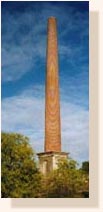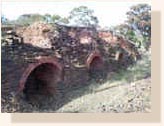Beehive Gold Mine site
Carman's tunnel
Derby Hill
Excavator and Gold Dredge
Maldon State Battery
North British Mine
Red, White and Blue Mine
South German Mine
Tarrangower Tunnelling Company Mine
Union Hill - open cut gold mining
Beehive Gold Mine site
 Remains
of the New Beehive Company gold mine, one of the largest
plants in the district and one of Victoria's biggest gold
producers. The mine yielded 210,000 ounces of gold from a
shaft that reached a depth of 396 metres. The 30 metre high
chimney designed by D R Drape, who also designed the
Hospital, was built in 1863 and served three boilers. The
capping and top two metres of the chimney was lost in 1923
after a lightning strike. Adjacent to the chimney can be
seen the remains of the shaft, also the stone and brick
substructures for the boilers, the winding engine,
compressor, pumping engine, battery engine and a twenty head
crushing battery. Remains
of the New Beehive Company gold mine, one of the largest
plants in the district and one of Victoria's biggest gold
producers. The mine yielded 210,000 ounces of gold from a
shaft that reached a depth of 396 metres. The 30 metre high
chimney designed by D R Drape, who also designed the
Hospital, was built in 1863 and served three boilers. The
capping and top two metres of the chimney was lost in 1923
after a lightning strike. Adjacent to the chimney can be
seen the remains of the shaft, also the stone and brick
substructures for the boilers, the winding engine,
compressor, pumping engine, battery engine and a twenty head
crushing battery.
Carman's tunnel
The tunnel was commenced in 1862 by by the The Great International Quartz
Mining Company in in an attempt to meet a reef that was
thought to run from Parkin's Reef to Lisle's Reef. The mine
was abandoned in 1884, progressing 425 metres into the Mount
after finding a negligible amount of gold. Tours are now run
into the mine.
Derby Hill

The hill on the western side of Main street, overlooks the town, and on the
walking track around the hill can still be seen the remains
of several mines and the Caledonian crushing battery.
Excavator and Gold Dredge

The dredge operation on Porcupine Creek at Porcupine Flat was started
some time after 1973 and operated until 1984 with only
moderate success. The dredge was constructed onsite and
copied one that had been used at Newstead, and the dragline
was brought in from the Yallourn open cut. The dredge
operated by excavating the bank with the conveyor belt of
buckets, carrying the dirt down a chute to where it was
processed, with the slurry being discharged at the rear
continually reforming the bank at the rear.
Maldon State Battery 
 The
State Government installed approximately sixty of these
batteries to service the smaller mining companies. This
battery, installed in 1914, is one of the few surviving
batteries and it is still in working order, although it is
no longer used. The battery appears to have been the busiest
of the State batteries, processing 17,572 tons of material.
The tailings that were the end product of the crushing
process form large dumps at the side of the battery. The
State Government installed approximately sixty of these
batteries to service the smaller mining companies. This
battery, installed in 1914, is one of the few surviving
batteries and it is still in working order, although it is
no longer used. The battery appears to have been the busiest
of the State batteries, processing 17,572 tons of material.
The tailings that were the end product of the crushing
process form large dumps at the side of the battery.
North British Mine

 This was the largest and one of the most profitable mines in
Maldon. It was the last major mine of that era to close, and
it closed down its operations in 1926. The Parkins Reef area
was initially mined by several companies, these were
consolidated into a single mining company, Parkins Reef
Quartz Mining Association, owned in partnership with Robert
Dent Oswald. Oswald bought out the Association in 1865 and
renamed it the North British and Quartz Mining and Crushing
Company. The mine employed 120 men working in three shifts,
the main shaft of the mine went to a depth of 503 metres and
yielded 203,307 ounces of gold.
This was the largest and one of the most profitable mines in
Maldon. It was the last major mine of that era to close, and
it closed down its operations in 1926. The Parkins Reef area
was initially mined by several companies, these were
consolidated into a single mining company, Parkins Reef
Quartz Mining Association, owned in partnership with Robert
Dent Oswald. Oswald bought out the Association in 1865 and
renamed it the North British and Quartz Mining and Crushing
Company. The mine employed 120 men working in three shifts,
the main shaft of the mine went to a depth of 503 metres and
yielded 203,307 ounces of gold.
Red, White and Blue Mine

Red, White and Blue Quartz Reef, Muckleford State Forest.
The earliest alluvial diggings date back to the 1850s with
the most recent operations dating from 1958. The mine shaft
was started in 1871 and reached a level of 52 metres. The
lease was acquired in 1958 by Golden Age Gold P/L and the
mine was reopened with a poppet head being brought from the
Deborah United Mine in Bendigo to operate the mine, but only
a small quantity of gold was extracted from the mine.
South German mine

Situated on a reef to the south-east of the town, the mine
was first started in 1855, but deep reef mining was carried
out by the South German Company from 1892. The mine worked
to a depth of 670 metres until flooding caused the mine to
close. The small lake on the site is fed by the water coming
from the mine shaft. The mine was one of the richest in the
area, yielding 191,231 ounces of gold. The mine was also one
of the first to use the cyanide extraction process.
Tarrangower Tunnelling Company Mine

The mine site is located near the drive to the top of Anzac
Hill. The site shows the opening to the mine, the tramway
cutting from the mine opening and a whim platform above the
tunnel. Mining at the site commenced in 1865 but progress
was extremely slow because of the hardness of the rock. The
introduction of an air drill, said to be the first one used
in Australia, increased the rate of progress.
Union Hill - open cut gold mining

In the 1980s an open cut mine at Union Hill was started and
processed remnant material from around the old Union Mine. A
processing plant was built at Porcupine Flat to process this
material. In 1994 Alliance Gold Mines was formed and mined
from a decline which was driven from the base of the open
cut mine. Operations were closed down in 1999 when gold
prices made production uneconomic. Alliance Gold Mines has recommenced
its gold mining operations and its decline entry is in the
existing open cut mine.
|
|